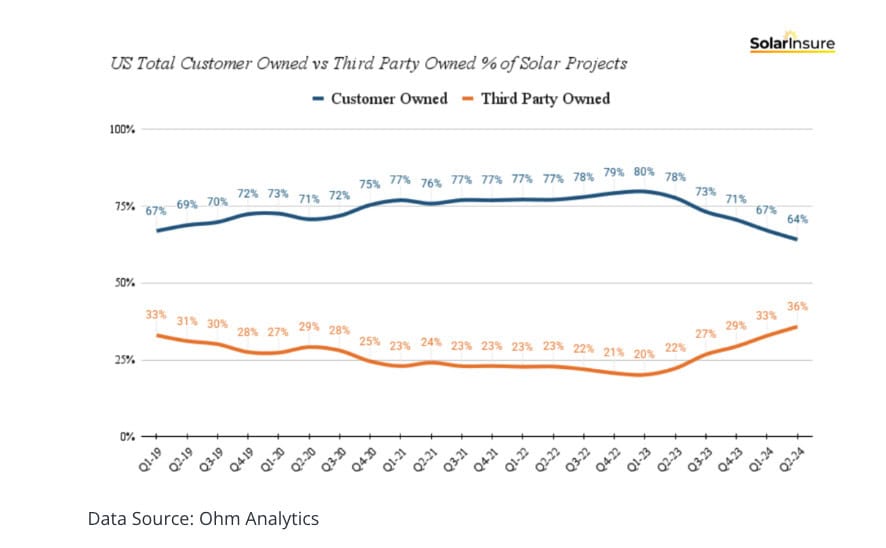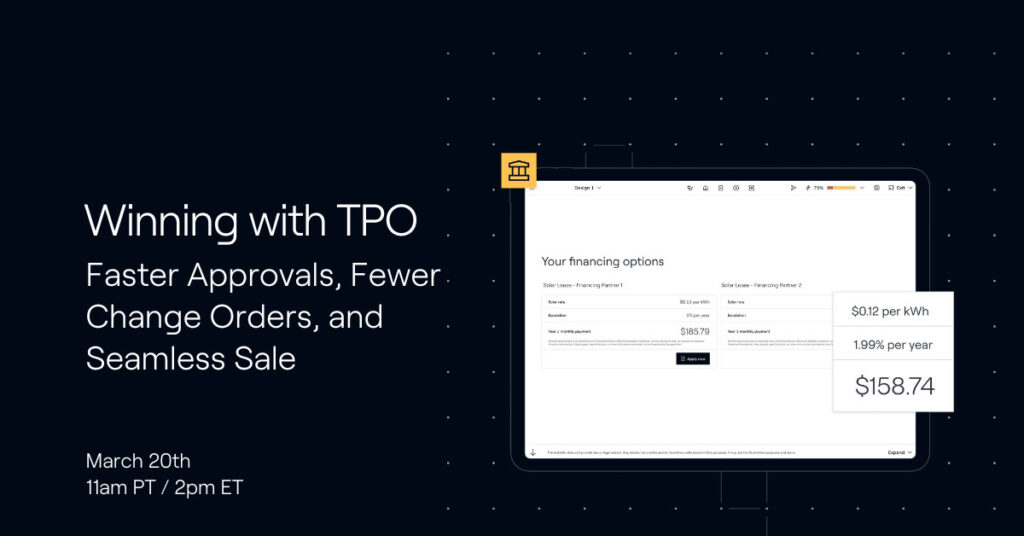The solar industry is no stranger to change, and one of the biggest agents of that change recently has been high interest rates. With the days of zero-interest loans a thing of the past (for now), homeowners and solar companies have sought out ways to make a solar install more affordable. Enter third-party ownership (TPO).
According to reports, TPO volumes increased by 32% in 2023. This trend continued through Q3 of 2024 with TPO market share growing to 43% nationally. When looking at key state markets (AZ, CA, CT, FL, IL, MA, NJ, NV, NY, PA, PR, TX), TPO share was 56%. This financing model is proving to be a game-changer — especially for homeowners who want the benefits of solar without the upfront costs.

Why is TPO growing?
As we touched on above, several factors are fueling the rise of TPO in the solar industry:
✅ High interest rates are making cash and loan financing less attractive, leading more homeowners to explore TPO options like leases and Power Purchase Agreements (PPAs).
✅ The Inflation Reduction Act (IRA) introduced 10% tax credit adders for qualifying TPO projects, making these options even more financially viable.
✅ Increased accessibility — TPO is helping lower-income households go solar. In 2023, 33% of solar adopters with an annual income below $50,000 used TPO, compared to only 18% of high-income households ($200,000+). Many industry experts expect a market recovery in 2025, and some attribute it to the growth in the TPO segment.
“We do expect a market recovery in 2025,” explained Zoë Gaston, Principal Analyst, US Distributed Solar “with 14% growth primarily driven by the momentum in the third-party ownership (TPO) segment and investment tax credit adder (ITC) qualification.”
Want to learn more? Check out our Winning with TPO webinar to get all your questions answered.

The road ahead
While TPO is growing, it can come with challenges. High interest rates are a double-edged sword, pushing homeowners toward TPO but also affecting demand for non-TPO financing models.
According to Ohm Analytics, “TPO’s market share is expected to continue to increase slightly into 2025 and into the mid-to-high 40% range as some providers expand to additional markets.” This shows that demand for flexible solar financing is continuing its upward trajectory.To capitalize on this trend, solar companies have to look at solutions that streamline the TPO process — for them and their customers — helping them reduce change orders, accelerate approvals, and ensure compliance with financier requirements.
The potential impact
It’s easy to talk about how TPO can help make solar more attractive to homeowners, and help installers sell more, but how does it work in practice?
- Our World Energy (OWE) has successfully scaled TPO adoption to 85% of its projects, but they did have some key challenges. OWE faced:
- Frequent change orders — impacting 40% of projects, delaying approvals, and increasing costs
- Site survey inefficiencies — extending survey times to 90 minutes and causing repeat visits
- Fragmented workflows — requiring multiple tools and manual rework
After significant research, OWE adopted Aurora’s TPO-integrated design and proposal platform, which helped them achieve:
- 75% fewer change orders
- 50% faster site surveys (from 90 minutes to 30-45 minutes)
- 72 hours saved per project
- Seamless integration with TPO providers for faster approvals
Want to get the details? Check out the full case study here.
What this means for solar companies
The future of TPO is bright, and solar businesses that embrace automation and AI-driven solutions will be best positioned to scale efficiently. By reducing inefficiencies in the TPO project lifecycle, companies can close deals faster, increase homeowner trust, and maximize growth opportunities.
Want to learn more?
- Schedule a quick demo to get your specific questions answered
- Read more about Our World Energy’s story for actionable tips
- Want to try it yourself? Check out our pricing page to see what works for you



